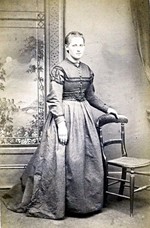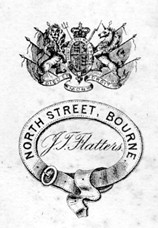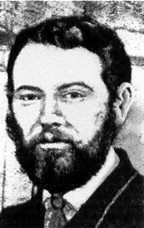 |
 |
 |
PHOTO FROM THE ATTIC REMEMBERS
BOURNE PIONEER
by Rex Needle
 |
 |
 |
PHOTO FROM THE ATTIC REMEMBERS
BOURNE PIONEER
by Rex Needle
|
A FADED PORTRAIT portrait that has been found in a box of old family photographs has revived memories of the Bourne man who took it before becoming the victim of a shoot-out in the wilds of North America. The small pasteboard card known as a carte de visite was a popular form of portrait photography in Victorian times when ladies and gentlemen had their likeness taken to give to friends and in many cases find a husband or wife. This one was discovered by Mrs Pat Cottam in the attic of her home in Doctor’s Lane, Rippingale. The portrait shows a pretty young lady in her best dress posing in the photographer’s studio with no identification other than the name Tess or perhaps Terri written on the back in pen. “The photographs came to me after a family bereavement and so she must be a relative from long ago”, said Mrs Cottam. “I have no idea who she is and no way of finding out but I did wonder about the photographer. The trade stamp on the back gives us a clue to his identity because it includes the name and address of Joseph Tye Flatters, who had premises in North Street during the mid-19th century. He was well known in Bourne as a bell-ringer at the Abbey Church and for playing the trumpet with the town band as well as serving with the Lincolnshire Rifle Volunteers, a part time military unit based in Bourne. Joseph had started his working life as a shop assistant with the grocery and drapery business Rodgers & Hester which was located in the market place on a site now occupied by the National Westminster Bank. The business also included a photography service, then in its infancy, in which he specialised and soon after marrying the boss’s daughter, Frances Hester, in 1865, he branched out on his own from rented premises in North Street. It was while working here that he took the photographs that survive today, a few showing the main streets and one of the town hall although his money spinner was the demand for cartes de visite which kept him busy and helped support a growing family, among them this example which has surfaced at Rippingale and therefore taken around 1870. But Joseph was an adventurous spirit and after reading in the newspapers many tales about the men who had emigrated to the New World and made their fortunes, he decided to follow and despite having a large family, sailed aboard the SS Scandinavia, a steamship with sailing masts, which departed from Liverpool on 19th May 1871, arriving in Quebec the following July with his wife and their four young children, sons Joseph, James and William and daughter Nellie. Twins had also been born to them in England but both had died before they emigrated although they were to have eight more children in Canada, but one, a baby girl called Fannie Lewella, died soon after Christmas in 1882, six weeks before her second birthday. The family settled at Aylmer, Quebec, but with little money to be had from photography, Joseph sought more remunerative employment and by 1879 was working as a sheriff and court bailiff, his many duties including serving subpoenas and collecting debts. He travelled his district on horseback and by buggy, switching to a sleigh when the snows came during the winter months, but after being involved in many life threatening situations, he discovered to his cost that the job could be a very dangerous one indeed. In June 1885, he stopped a young lad, Daniel Ardell, aged 14, for questioning about a stolen watch. The boy had a gun, panicked and shot Joseph in the hip. The bullet lodged deep in the flesh and doctors were unable to extract it and he died two weeks later on 1st July 1885, aged 43 years. Ardell was tried and sentenced to 14 years in prison. The killing left Joseph's widow, Frances, in difficult circumstances and although the two eldest boys, John and William, were already working, she had Nellie and seven other children that had been born in Canada still to support, among them three-months-old Josephine, the latest addition to the family who had arrived on 20th March 1885. But Joseph had been a careful man who had taken out an insurance policy on his life for $1,000 and so his family would not have been left penniless and the town council also voted to pay Joseph's widow his entire year's salary of $400 that he would have received. Frances lived to be 84 and died at Aylmer on 31st August 1928, but not before she had returned to Bourne for a visit in 1906, sailing from Quebec aboard the steamer Empress of Ireland, her first visit home since she had left for a life in the unknown 35 years before. Her youngest daughter Josephine was the mother of Mrs Ethel Guertin, now aged 95, who lives in Gatineau, Quebec, and who has told me this stirring tale of her grandfather, one of the early pioneers from Bourne who helped bring stability to a small and then untamed part of the North American wilderness, and of her grandmother who was left with a large family and little else but hope to bring them up but showed true pioneering spirit to smooth the path for their survival. Today, their extended family is a large one and spread throughout North America. Joseph Flatters was father to thirteen children and although three of them died in infancy, eight of the remaining ten bore him 33 grandchildren and, at the latest count, more than 60 great grandchildren, all living in various parts including Aylmer, Ottawa, Quebec, Halifax, Montreal and Toronto in Canada and Ohio, West Virginia and Texas in the United States. Meanwhile, granddaughter Ethel still keeps in touch with the town where her family originated through the Bourne web site and regular emails. “From your photographs and descriptions, it does seem to be a lovely place and it is my one regret that I never had the opportunity to visit”, she said. |
NOTE: This article was published by The Local newspaper on Friday 29th November 2013.
Return to List of articles